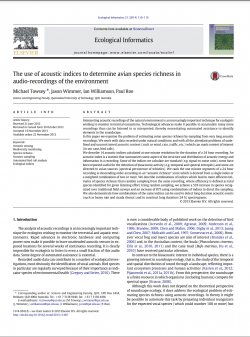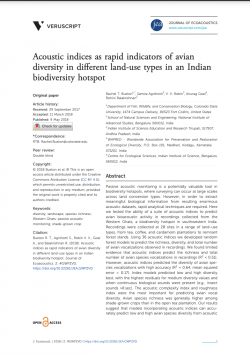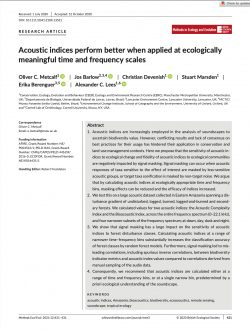The use of acoustic indices to determine avian species richness in audio-recordings of the environment

Type
Journal
Authors
Category
Article
[ Browse Items ]
Publication Year
2014
Publisher
Ecological Informatics, United States
URL
[ private ]
Volume
21
Pages
110-119
Tags
Abstract
Interpreting acoustic recordings of the natural environment is an increasingly important technique for ecologists wishing to monitor terrestrial ecosystems. Technological advances make it possible to accumulate many more recordings than can be listened to or interpreted, thereby necessitating automated assistance to identify elements in the soundscape.
In this paper we examine the problem of estimating avian species richness by sampling from very long acoustic recordings. We work with data recorded under natural conditions and with all the attendant problems of undefined and unconstrained acoustic content (such as wind, rain, traffic, etc.) which can mask content of interest (in our case, bird calls).
We describe 14 acoustic indices calculated at one minute resolution for the duration of a 24 hour recording. An acoustic index is a statistic that summarizes some aspect of the structure and distribution of acoustic energy and information in a recording. Some of the indices we calculate are standard (e.g. signal-to-noise ratio), some have been reported useful for the detection of bioacoustic activity (e.g. temporal and spectral entropies) and some are directed to avian sources (spectral persistence of whistles). We rank the one minute segments of a 24 hour recording in descending order according to an “acoustic richness” score which is derived from a single index or a weighted combination of two or more. We describe combinations of indices which lead to more efficient estimates of species richness than random sampling from the same recording, where efficiency is defined as total species identified for given listening effort. Using random sampling, we achieve a 53% increase in species recognized over traditional field surveys and an increase of 87% using combinations of indices to direct the sampling.
We also demonstrate how combinations of the same indices can be used to detect long duration acoustic events (such as heavy rain and cicada chorus) and to construct long duration (24 h) spectrograms.
In this paper we examine the problem of estimating avian species richness by sampling from very long acoustic recordings. We work with data recorded under natural conditions and with all the attendant problems of undefined and unconstrained acoustic content (such as wind, rain, traffic, etc.) which can mask content of interest (in our case, bird calls).
We describe 14 acoustic indices calculated at one minute resolution for the duration of a 24 hour recording. An acoustic index is a statistic that summarizes some aspect of the structure and distribution of acoustic energy and information in a recording. Some of the indices we calculate are standard (e.g. signal-to-noise ratio), some have been reported useful for the detection of bioacoustic activity (e.g. temporal and spectral entropies) and some are directed to avian sources (spectral persistence of whistles). We rank the one minute segments of a 24 hour recording in descending order according to an “acoustic richness” score which is derived from a single index or a weighted combination of two or more. We describe combinations of indices which lead to more efficient estimates of species richness than random sampling from the same recording, where efficiency is defined as total species identified for given listening effort. Using random sampling, we achieve a 53% increase in species recognized over traditional field surveys and an increase of 87% using combinations of indices to direct the sampling.
We also demonstrate how combinations of the same indices can be used to detect long duration acoustic events (such as heavy rain and cicada chorus) and to construct long duration (24 h) spectrograms.
Description
https://doi.org/10.1016/j.ecoinf.2013.11.007
Number of Copies
1
| Library | Accession No | Call No | Copy No | Edition | Location | Availability |
|---|---|---|---|---|---|---|
| Main | 340 | 1 | Yes |



